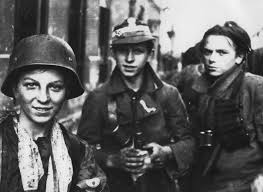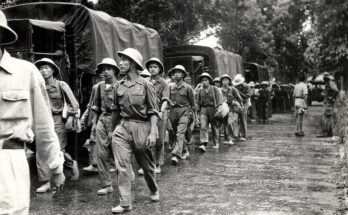The Warsaw Uprising of 1944 stands as one of the most remarkable acts of resistance during World War II. It was a desperate, heroic effort by the Polish underground to liberate Warsaw from Nazi occupation. Although it ultimately ended in tragedy, the uprising remains a powerful symbol of courage, unity, and the indomitable human spirit in the face of overwhelming odds. In this article, we’ll delve into the background, events, and legacy of the Warsaw Uprising, exploring its significance in the broader context of the war and Polish history.
Table of Contents
- Introduction
- What Sparked the Warsaw Uprising?
- The Political Context: Poland in World War II
- The Role of the Home Army (Armia Krajowa)
- Planning the Uprising
- The Beginning: August 1, 1944
- Key Battles and Strategic Locations
- Daily Life During the Uprising
- Nazi Germany’s Brutal Response
- The Role of the Soviet Union
- International Reactions and Allied Support
- Why Did the Uprising Fail?
- Aftermath: The Destruction of Warsaw
- The Legacy of the Warsaw Uprising
- Conclusion
Introduction
Imagine a city fighting for its freedom, its citizens banding together against a powerful enemy despite knowing the odds are stacked against them. That’s exactly what happened in Warsaw during the summer of 1944. The Warsaw Uprising wasn’t just a military operation it was a manifestation of a nation’s yearning for independence and dignity. But what led to this extraordinary event, and why did it end in such devastation? Let’s uncover the story.
What Sparked the Warsaw Uprising?
The Warsaw Uprising wasn’t a spontaneous event. It was born out of years of suffering under Nazi occupation and a desperate hope to reclaim freedom before the Soviet Army arrived. By mid-1944, the Red Army was advancing westward, and the Polish underground hoped to liberate Warsaw to assert control before Soviet forces could impose their influence.
The Political Context: Poland in World War II
Poland’s experience during World War II was uniquely harrowing. Invaded by both Nazi Germany and the Soviet Union in 1939, the country was caught between two brutal regimes. While the Nazis imposed terror in occupied Poland, the Soviets sought to suppress Polish independence in the eastern territories. The Warsaw Uprising occurred against this backdrop of dual oppression, making it both a fight against Nazism and a statement of resistance to Soviet domination.
The Role of the Home Army (Armia Krajowa)

The Home Army (Armia Krajowa, or AK) was the backbone of Polish resistance. It was the largest underground resistance movement in occupied Europe, with over 400,000 members at its peak. The AK’s primary goal was to fight for Polish sovereignty, and its leaders played a crucial role in planning and executing the Warsaw Uprising.
Planning the Uprising
Planning the uprising was a monumental challenge. The AK faced a well-armed and experienced German military with limited resources of its own. The decision to launch the uprising was made in late July 1944, with leaders believing that the Red Army’s imminent arrival would provide much-needed support. Unfortunately, this assumption proved tragically flawed.
The Beginning: August 1, 1944
On August 1, 1944, the uprising began. At 5:00 PM, codenamed “W-hour,” around 40,000 members of the AK launched a coordinated assault against German forces in Warsaw. Initially, the insurgents captured key positions, including police stations and communication hubs. The sight of Polish flags flying over liberated areas filled the city’s residents with hope.
Key Battles and Strategic Locations
Fighting in Warsaw was intense and chaotic. Key battles centered around the Old Town, the Warsaw Ghetto ruins, and the city’s bridges. The AK fighters, armed with homemade weapons and captured German equipment, displayed extraordinary bravery. However, the Germans retaliated with brutal efficiency, deploying tanks, heavy artillery, and airstrikes.
Daily Life During the Uprising
For the civilians of Warsaw, the uprising brought a mix of hope and horror. People lived in makeshift shelters, enduring constant bombardment. Food and water were scarce, and medical supplies quickly ran out. Despite the hardships, the population supported the resistance fighters, sharing whatever resources they could.
Nazi Germany’s Brutal Response
The German response to the uprising was devastating. Adolf Hitler ordered the complete destruction of Warsaw as punishment for the rebellion. SS troops and Wehrmacht units committed horrific atrocities, massacring tens of thousands of civilians and systematically razing the city. Entire neighborhoods were reduced to rubble.
The Role of the Soviet Union
One of the most controversial aspects of the Warsaw Uprising is the Soviet Union’s inaction. Despite being positioned just across the Vistula River, the Red Army made no effort to assist the insurgents. Historians argue that Stalin deliberately withheld support, preferring to let the uprising fail to weaken the Polish resistance.
International Reactions and Allied Support
While the uprising garnered sympathy from Allied nations, tangible support was limited. The British and Americans conducted airdrops of supplies, but these were often insufficient and poorly coordinated. Political considerations, including strained relations with the Soviet Union, prevented a more robust response.
Why Did the Uprising Fail?
The Warsaw Uprising failed for several reasons. The insurgents were vastly outgunned, and their reliance on Soviet support proved misplaced. The German forces, though stretched thin, were ruthless and well-organized. Additionally, the Allies’ reluctance to challenge Stalin’s stance left the AK isolated.
Aftermath: The Destruction of Warsaw
After 63 days of fierce fighting, the Warsaw Uprising ended on October 2, 1944. The city lay in ruins, and over 200,000 civilians and fighters had perished. The survivors faced deportation or execution, and Warsaw itself was systematically destroyed by German forces in the months that followed.
The Legacy of the Warsaw Uprising
The Warsaw Uprising left a profound legacy. While it failed to achieve its immediate goals, it became a symbol of Polish resilience and determination. In post-war Poland, the uprising was initially suppressed by the communist regime, but it has since been embraced as a defining moment in the nation’s history. Memorials, museums, and annual commemorations ensure that the bravery of those who fought is never forgotten.
Conclusion
The Warsaw Uprising was a tragic yet inspiring chapter in World War II history. It showcased the extraordinary courage of ordinary people willing to risk everything for freedom. While its outcome was devastating, the uprising’s legacy continues to resonate, reminding us of the human capacity for resilience and hope in the darkest times.
FAQs
1. What was the main goal of the Warsaw Uprising?
The main goal was to liberate Warsaw from Nazi control and assert Polish sovereignty before the Soviet Army could establish dominance.
2. How long did the Warsaw Uprising last?
The uprising lasted for 63 days, from August 1 to October 2, 1944.
3. How many people died during the Warsaw Uprising?
Approximately 200,000 people, including both civilians and resistance fighters, lost their lives.
4. Why didn’t the Soviet Union help during the uprising?
The Soviet Union did not assist, likely because Stalin wanted to weaken the Polish resistance and solidify Soviet control over post-war Poland.
5. What is the significance of the Warsaw Uprising today?
The uprising is a symbol of Polish resilience and the fight for freedom. It is commemorated annually as a testament to the courage of those who fought against tyranny.


